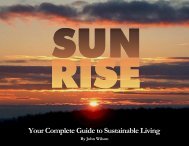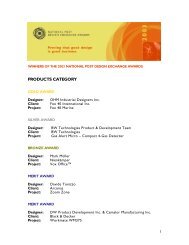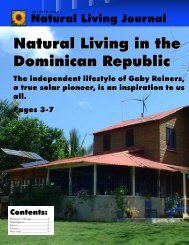Volume 3 - Program & Project Ideas (PDF - 4.5 - Natural Life Network
Volume 3 - Program & Project Ideas (PDF - 4.5 - Natural Life Network
Volume 3 - Program & Project Ideas (PDF - 4.5 - Natural Life Network
You also want an ePaper? Increase the reach of your titles
YUMPU automatically turns print PDFs into web optimized ePapers that Google loves.
<strong>Natural</strong> Resources Canada – Community Energy Systems<br />
WATER USE OPPORTUNITIES<br />
W.1.1 Water efficient landscaping<br />
Water efficient landscaping involves seven steps: design, including the grading,<br />
positioning of plants and drainage; adding organic materials to clays and sandy soils to<br />
improve the nutrient holding capacity; reducing the turf areas; mulching to reduce weed<br />
growth and hold moisture; irrigating plants following a zone system and watering<br />
according to plant needs and using water-saving methods; placing plants so that those<br />
with similar water needs are placed together; and proper maintenance, such as mowing<br />
and fertilizing.<br />
• Water efficient landscaping reduces maintenance time and costs, as well as<br />
water use by as much as 60 per cent.<br />
Source: CMHC. 2000. Practices for Sustainable Communities, p141-142. For additional<br />
information, contact the Department of Horticultural Science, University of Saskatchewan,<br />
Saskatoon, SASK S7N 0W0.<br />
W.1.2 Roof top gardens<br />
(See roof top gardens under the building planning opportunities section)<br />
Roof top gardens, such as in the above photo<br />
from Dakar, can reduce the water runoff rate<br />
and volume by up to 75 per cent, filter<br />
pollutants from water, and reduce the<br />
temperature of the water runoff, causing less<br />
environmental impact.<br />
W.1.3 Storm water management-drainage techniques<br />
Downspouts or eaves troughs transfer water from roofs to the ground level. In some<br />
cases these downspouts are directly attached to the municipal sewage system. In built<br />
neighbourhoods downspouts are disconnected; in new developments, they are prohibited.<br />
• Storm water runs off naturally into the ground, oils and other materials can be<br />
naturally filtered, reducing the impact on rivers and streams.<br />
• Water can be stored and used to irrigate plants and lawns.<br />
Draft 4/11/2005 96






